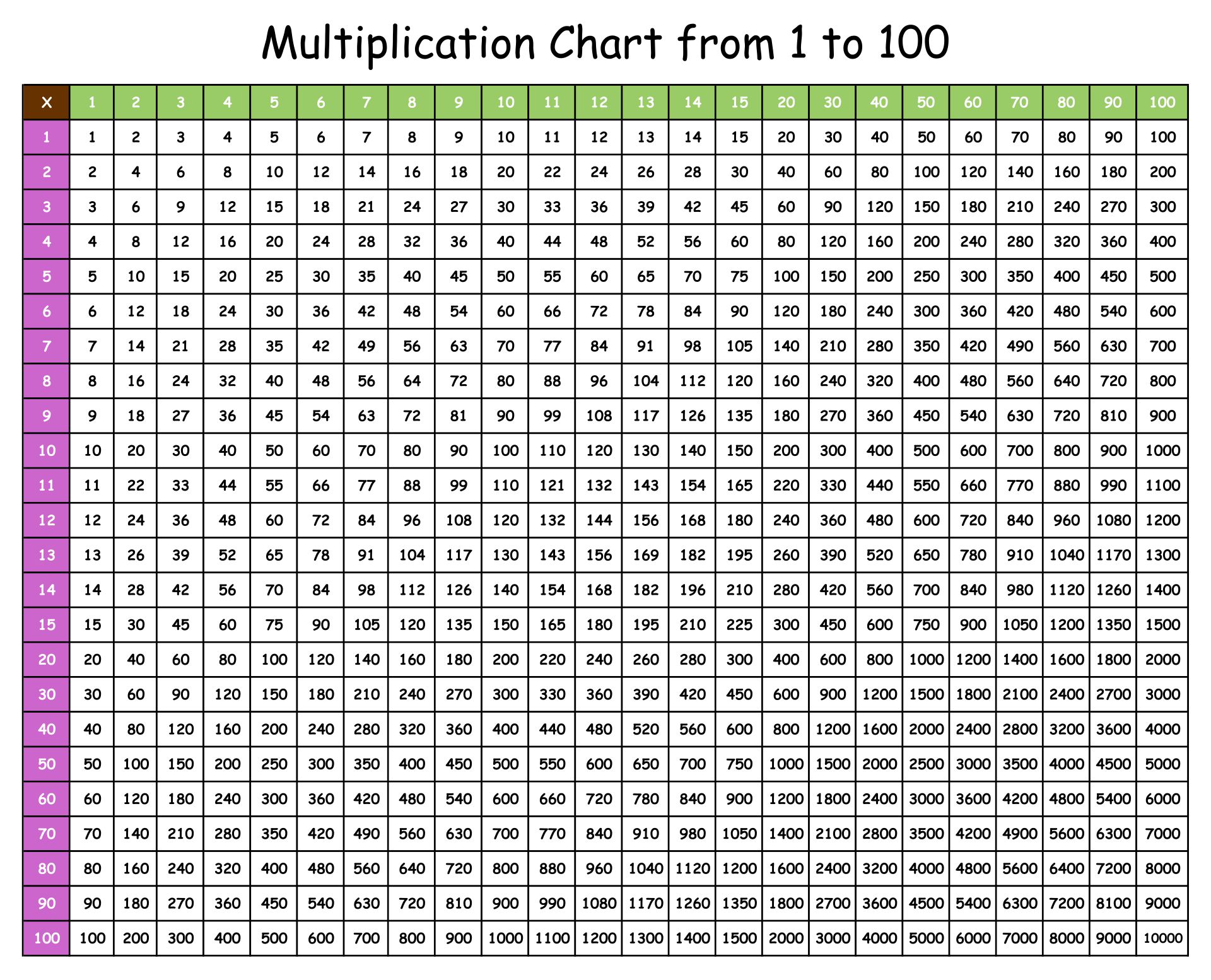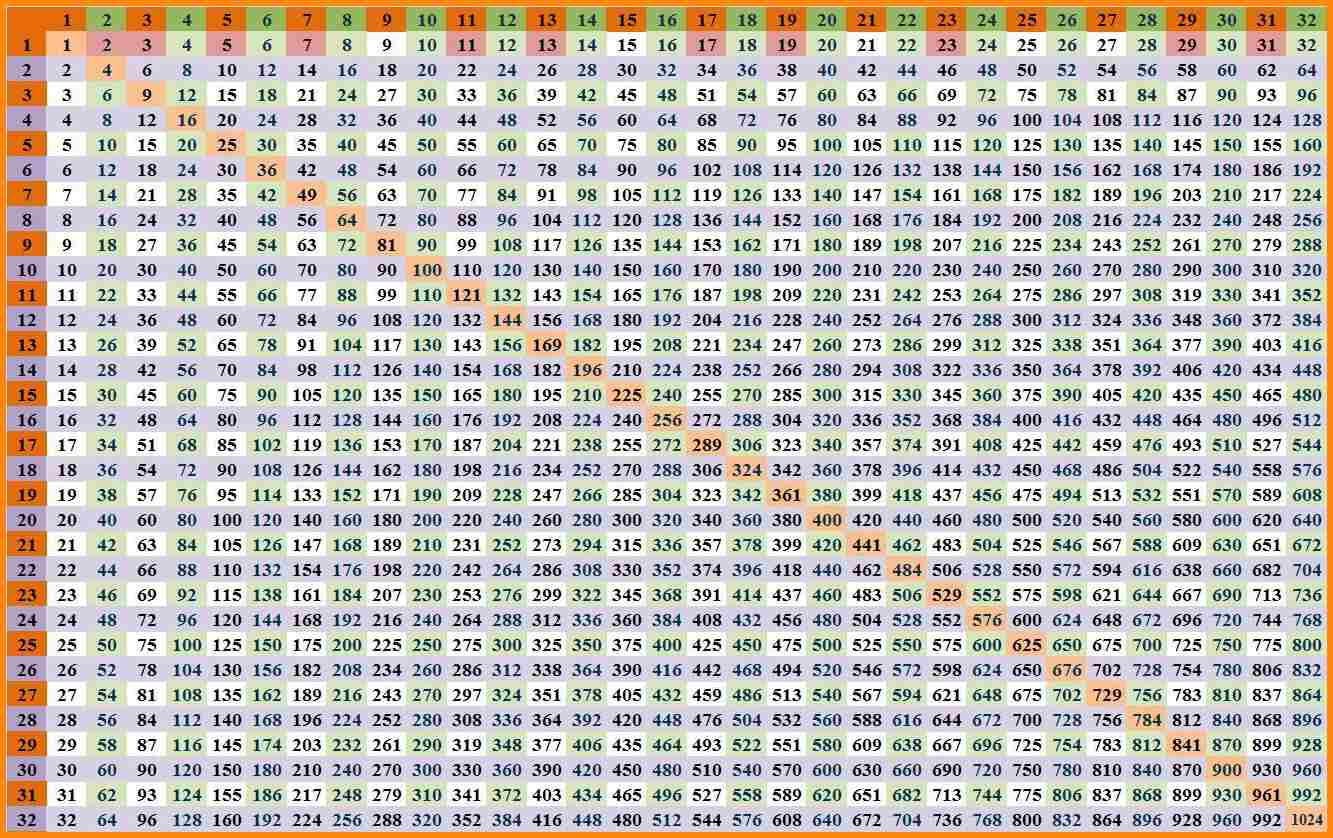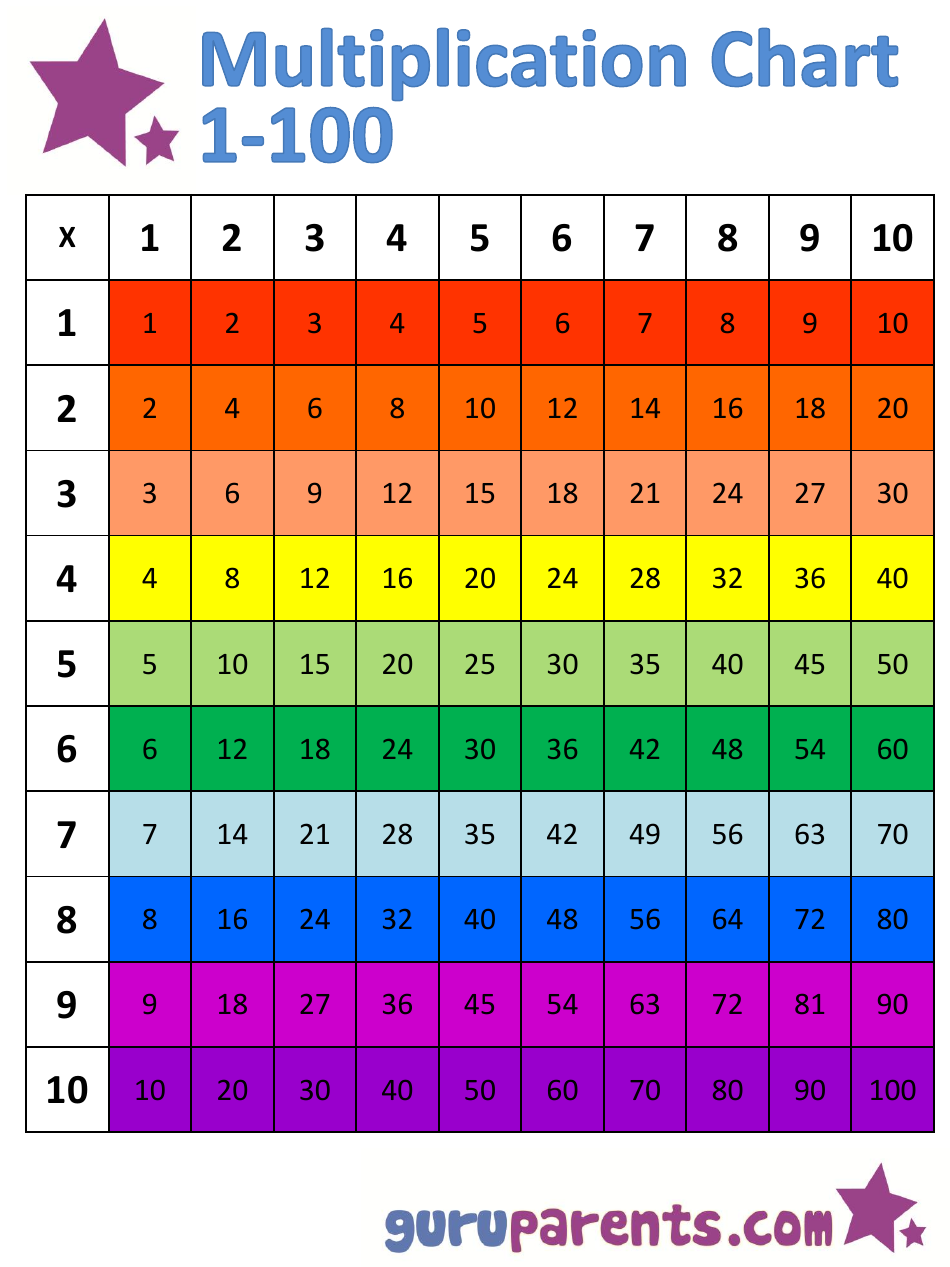Learning multiplication can feel like a big puzzle for many kids, and even some adults. Getting those numbers to stick in your head, well, it's almost a common challenge. That's why having a good tool, like a multiplication chart 1-100, can make all the difference. It's a visual help that really takes the guesswork out of figuring out those times tables. So, if you're looking for a way to make math facts less scary and more fun, this chart is definitely something to consider.
A multiplication chart 1-100 is, in a way, a secret weapon for anyone trying to get better at math. It shows you the answers for various multiplication problems, laid out in an easy-to-see grid. This kind of chart helps you quickly find what you need, whether you are just starting out with multiplication or you are trying to speed up your recall. It is that kind of resource that supports learning at your own pace, which is pretty helpful, you know.
This article will look at what makes a multiplication chart 1-100 so useful, how you can use it every day, and where to find the best versions. We will also talk about the real benefits this simple tool brings to learning, helping you or your child get a good handle on math facts. You will find, too, some tips for making the most of it, which is something many people want to know about right now.
Table of Contents
- What is a Multiplication Chart 1-100?
- Why These Charts Are a Big Help
- How to Use Your Multiplication Chart 1-100
- Finding the Best Multiplication Chart 1-100
- Frequently Asked Questions
- Making the Most of Your Chart
What is a Multiplication Chart 1-100?
A multiplication chart 1-100 is, quite simply, a grid that shows you the products of numbers when they are multiplied together. Typically, it lists numbers from 1 to 10 (or sometimes 12) across the top and down the side. Where the row and column meet, you find the answer to that multiplication problem. For instance, where the '5' row meets the '7' column, you will see '35'. It's a very straightforward visual aid, which is pretty nice.
This kind of chart is called "1-100" because it helps you learn all the multiplication facts that result in products up to 100, and sometimes a little more. For example, a 10x10 chart covers products like 10 times 10, which is 100. It's a fundamental resource for building a strong math foundation, and many people find it extremely helpful for young learners, too, as a matter of fact.
It acts like a quick reference guide. When you are not sure what 8 times 9 is, you can just look it up. Over time, as you use the chart more and more, you start to remember the answers without needing to look. This is how it helps move from looking things up to knowing them by heart, which is the main goal, obviously.
Why These Charts Are a Big Help
Multiplication charts are not just pieces of paper with numbers; they are powerful learning tools. They help in several important ways, making the whole process of learning times tables much smoother. You know, they are very effective for visual learners, especially.
Making Learning Easier
For many, math facts can feel overwhelming. A multiplication chart 1-100 breaks down this big task into smaller, more manageable pieces. You can see patterns, like how numbers ending in 0 or 5 behave, or how the order of numbers does not change the product. This visual organization makes the information less intimidating and more accessible, which is a big deal for kids.
It provides a clear, consistent way to see the relationships between numbers. This helps kids, and adults too, build a mental picture of the multiplication facts. It is like having a map for the world of numbers, helping you find your way around easily. This visual approach, honestly, makes a huge difference in how quickly someone can grasp the concepts.
Without this visual aid, learning might just involve rote memorization, which can be boring and less effective for some. The chart, however, adds a visual element that engages a different part of the brain, making the learning process more complete. So, it is pretty good for different learning styles, you know.
Boosting Confidence
When a child can quickly find an answer on the chart, they feel a sense of accomplishment. This small success builds confidence, which is really important for learning anything new. It takes away the fear of getting an answer wrong, because the correct answer is always right there, ready to be found. This support, you know, is truly vital for keeping motivation high.
This newfound confidence can then spill over into other areas of math. If a child feels good about their multiplication skills, they are more likely to approach division, fractions, and even algebra with a positive attitude. It is a stepping stone, in a way, to broader math success. So, it is not just about multiplication, actually.
The chart gives them a safety net, allowing them to try problems without the pressure of having to know the answer instantly. This reduces anxiety and encourages them to keep practicing. It's almost like having a friendly helper by their side, which is a pretty comforting thought for a learner.
A Great Practice Tool
A multiplication chart 1-100 is not just for looking up answers; it is also perfect for practice. You can cover up parts of the chart and try to guess the answers, then check your work. This active way of learning helps to cement the facts in your memory. It is a very versatile tool for daily practice, too.
You can use it for timed drills, where you try to fill in a blank chart as fast as you can, then use the full chart to check your answers. This makes practice engaging and helps improve speed and accuracy. Many teachers and parents find this method very effective, as a matter of fact.
It also allows for self-correction. If you get an answer wrong, you can immediately see the correct one and understand where you made a mistake. This instant feedback is crucial for effective learning and helps prevent bad habits from forming. So, it is pretty much a continuous learning loop, which is great.
How to Use Your Multiplication Chart 1-100
Using a multiplication chart 1-100 is simple, but there are different ways to get the most out of it, depending on what you are trying to achieve. Whether you are just starting or looking to speed things up, the chart can help. It is very adaptable, which is a good thing.
For Beginners
If you are new to multiplication, start by using the chart to find answers. Pick a problem, like 3 times 4. Find '3' on the left side and '4' on the top. Follow the row and column until they meet. The number you see there, which is 12, is the answer. Do this often, and you will start to see how it works, you know.
Focus on one set of facts at a time, like the 2s table or the 5s table. Use the chart to practice these specific facts until you feel comfortable with them. Then move on to the next set. This step-by-step approach makes learning less overwhelming, which is important for beginners, obviously.
You can also use your fingers to trace the rows and columns, helping your eyes stay on track. This physical interaction can make the process more concrete for young learners. It's a simple trick, but it really helps, too, in some respects.
For Speedy Recall
Once you are familiar with the facts, use the chart to test your speed. Try to recall the answer to a problem before you look it up. Then, quickly check the chart to see if you were right. This helps train your brain to retrieve the information faster. It's like a mental workout, pretty much.
You can also play games where you challenge yourself or others to answer as many facts as possible in a short amount of time, using the chart only for checking. This adds a fun element to practice and helps improve fluency. Many people find this competitive aspect very motivating, as a matter of fact.
Another idea is to create flashcards and use the chart to verify your answers. This combines two effective learning methods. The chart becomes your answer key, always there to confirm your knowledge, which is quite reassuring, you know.
Using It for Bigger Problems
Even when you move on to multiplying larger numbers, the multiplication chart 1-100 still has a role. It helps you quickly recall the basic facts needed for multi-digit multiplication. For example, if you are multiplying 23 by 4, you still need to know 3 times 4 and 2 times 4. The chart keeps those basic facts fresh. So, it is pretty useful for foundational knowledge.
It serves as a constant reminder of the building blocks of math. When you are doing long multiplication, being able to quickly pull up those smaller facts from memory saves a lot of time and effort. This allows you to focus on the more complex steps of the larger problem, which is a good thing, definitely.
Think of it as your reliable sidekick in math. It might not solve the whole big problem, but it makes sure you have all the small pieces you need readily available. This makes the overall process smoother and less prone to errors, too, in a way.
Finding the Best Multiplication Chart 1-100
There are many places to find multiplication charts, and they come in various styles. The "My text" tells us a lot about where to look and what to expect. You can find many designs, which is pretty neat, actually.
Printable Options
As mentioned in "My text," you can find a "multiplication table chart 1 to 100 in printable format for your kids." This is really convenient because you can print it right from your home computer. Many sites offer these charts for free, which is great for parents and teachers alike.
You can get "free printable multiplication chart that goes from 1 to 100 in pdf format for easy learning and practice." This means you can download it and print it whenever you need it. Having a physical copy is often better for learning than just looking at a screen, too, for many people.
These printable charts are perfect for hanging on a wall, putting in a binder, or even laminating for repeated use. The ease of access makes them a very popular choice. You can always have one ready, which is very helpful, you know.
Different Designs
"My text" also highlights that there are "many designs of 1 to 100 multiplication chart." This is a fun aspect, as you can choose a chart that appeals to your child's interests. Some might have bright colors, while others might be more minimalist.
You can find "cute & free printable multiplication chart 1 to 100 in black & white and pretty pastel colors." This variety means you can pick something that is visually appealing and engaging. A chart that looks good is more likely to be used regularly, which is pretty much true for anything, really.
Whether you prefer a simple, clear layout or something more decorative, the options are out there. This personalization can make learning feel less like a chore and more like a fun activity, which is a great thing, honestly.
Worksheets for Practice
Beyond just the charts, "My text" also mentions "multiplication worksheet for practice in." These worksheets often go hand-in-hand with the charts, providing problems for students to solve. They are essential for putting the chart's information into action.
You can get "pdf downloads for the full table as well as worksheets." This means you have a complete package for learning and practicing. The worksheets help reinforce what you learn from the chart, turning passive looking into active recall. So, it is a pretty complete system, you know.
"Our list of individual multiplication table worksheets ranging from the desired number up to multiples of 10, 12, 20, 50 and 100" shows the breadth of practice available. This variety helps target specific learning needs and ensures comprehensive coverage of facts. It is very useful for different stages of learning, too, as a matter of fact.
Frequently Asked Questions
People often have questions about using multiplication charts. Here are some common ones that come up, which are pretty relevant, you know.
How do you use a multiplication chart 1-100?
You use a multiplication chart 1-100 by finding one number on the top row and the other number on the left column. Then, you trace your finger or eye across and down until the row and column meet. The number where they meet is the answer to your multiplication problem. It's a simple lookup tool, basically.
What are the benefits of using a multiplication chart?
The benefits of using a multiplication chart are many. It helps make learning facts easier by providing a visual aid. It builds confidence as learners can quickly find answers. It also serves as a great tool for practicing and improving speed and recall. Plus, it is a very good foundation for more complex math, too, as a matter of fact.
Is a 100x100 multiplication chart useful?
A standard multiplication chart 1-100 typically refers to a chart that covers products up to 100, usually a 10x10 or 12x12 grid. A literal 100x100 chart would be very large and generally not practical for everyday learning of basic facts. The most useful charts focus on the foundational facts that are often used, like those up to 10x10 or 12x12. So, a truly massive chart is not usually what people mean, you know.
Making the Most of Your Chart
To really get the most out of your multiplication chart 1-100, it is good to use it consistently. Make it a regular part of your math routine. Just a few minutes each day can make a big difference over time. It is about steady effort, pretty much.
Consider placing the chart where it is easily seen, like on a desk or refrigerator. This constant visual presence helps reinforce the facts even when you are not actively studying. It's a passive way of learning that is very effective, too, in a way.
Remember that learning multiplication is a process. The chart is a fantastic tool to help along the way, but it works best when combined with regular practice and patience. You can learn more about effective study methods on our site, which is pretty helpful for all kinds of learning. And for more specific practice, you might want to link to this page for advanced multiplication techniques.
For more general math help, you can look at resources from educational organizations. For instance, the National Council of Teachers of Mathematics often has good advice for teaching math concepts, which is a good external resource to consider, obviously.
So, whether you are a student just starting out, a parent helping with homework, or an educator in the classroom, the multiplication chart 1-100 is a valuable asset. It truly helps to "enhance your math skills with this comprehensive chart, perfect for students and" anyone looking to improve their number fluency. It is a simple tool with big potential, which is something to think about, definitely.



Detail Author:
- Name : Vern Hickle
- Username : isom.larson
- Email : arempel@hotmail.com
- Birthdate : 1970-11-26
- Address : 8385 Cormier Mountains Suite 073 Virgilton, MN 27637-9426
- Phone : +1.305.697.4013
- Company : Grant, Senger and Prohaska
- Job : Data Entry Operator
- Bio : Et assumenda praesentium quas dolorum quis. Blanditiis soluta quas dicta sed veritatis modi. Distinctio quos et nostrum aliquam architecto officiis aut.
Socials
twitter:
- url : https://twitter.com/smith2021
- username : smith2021
- bio : Excepturi magnam quis qui vero voluptas. Cumque consequatur quo quo. Minima est pariatur facere unde.
- followers : 2729
- following : 2795
instagram:
- url : https://instagram.com/smith1996
- username : smith1996
- bio : Ipsa pariatur sed omnis et rem. Consequuntur in cum iusto saepe cum sed vel.
- followers : 6022
- following : 1346
facebook:
- url : https://facebook.com/smithh
- username : smithh
- bio : Sunt magni enim sed exercitationem.
- followers : 2915
- following : 585
linkedin:
- url : https://linkedin.com/in/hyman_smith
- username : hyman_smith
- bio : Repellat culpa earum ut nesciunt.
- followers : 4264
- following : 1692
tiktok:
- url : https://tiktok.com/@smithh
- username : smithh
- bio : Cum unde sequi iusto saepe tempore cupiditate eos.
- followers : 6016
- following : 1661



























